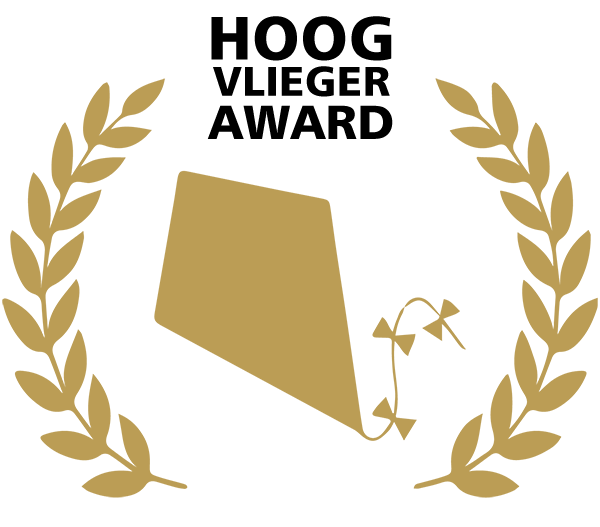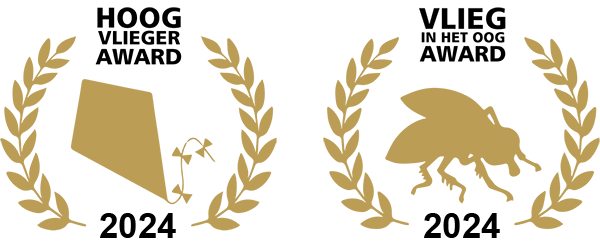
HuCom Awards
The Humanitarian Communication Awards are annual awards given to the most and least succesful campaign of a Dutch INGO, respectively the High Flyer Award (‘Hoogvlieger Award’) and Fly in the Eye Award (‘Vlieg in ‘t Oog’). The winners are selected by a yearly changing jury of experts who evaluate the five nominations in each category brought forward by our board and volunteers, after a careful review of all the Dutch INGO campaigns disseminated in the past year.
Archive Humanitarian Communication Awards 2024
Archive Humanitarian Communication Awards 2023
Archive Humanitarian Communication Awards 2022
Archive Humanitarian Communication Awards 2021
Archive Humanitarian Communication Awards 2020
Why do we organise the Humanitarian Communication Awards?
The Expertise Centre Humanitarian Communication is a non-profit organization committed to better communication in international development. One way to bring representation issues of fundraising and advoacy campaigns under the attention and on the agenda in the Netherlands is by organizing the annual Humanitarian Communication Awards.
With the Awards we aim to heighten awareness and encourage discussion of these issues by providing examples for best and worst practices of humanitarian communication. The Humanitarian Communication Awards are inspired by the Rusty Radiator Awards (Radi-Aid Awards), the annual awards created by the Norwegian Students’ & Academics’ International Assistance Fund (SAIH) with the aim ‘to challenge perceptions around issues of poverty and development, to change the way fundraising campaigns communicate, and to break down dominating stereotypes.’
Read here the interview about the Humanitarian Communication Awards 2022 with our chair, and the chair of the 2022 jury, Anika Altaf, on Nieuw Wij (in Dutch).
Read here the article about the Humanitarian Communication Awards 2020 by our directors, Wouter Oomen and Emiel Martens, on One World (in Dutch) and ZAM Magazine (in English).
Listen here to radio interview about the Humanitarian Communication Awards 2018 with one of our directors, Wouter Oomen, on Dit is de Nacht (NPO1) (in Dutch):
How are the nominees and winners of the Humanitarian Communication Awards selected?
Throughout the year we are always on the lookout for best and worst practices in humanitarian communication and actively approach people to send in campaigns they think are problematic or successfull. Once a year, usually in April, the (managing and supervisory) board and various expert volunteers get together to discuss all the campaigns of the past year. We look at all the communications of Dutch INGOs that are part of Partos as well as all other Dutch INGOs we know of and decide on the five campaigns to select in each category based on our Communication Code (see below) as well as other literature on the topic. We then announce the nominations for the Highflyer Award (‘Hoogvlieger’) and Fly in the Eye Award (‘Vlieg in het Oog’) and present them on our website and social media. We also inform the organizations in question about their nomination (or special mention). Finally, an annually changing expert jury selects the best and worst ‘imaging in humanitarian communication’ of the past year. The winners of both awards are then presented online, usually in June or July, and of course communicated to the organnizations
Hoogvlieger Award (High Flyer Award)
Do you know a campaign of a Dutch INGO that tells a nuanced story, is transparant, gives people in vulnerable situations a platform, creates realistic expectations, shares context, engages in participatory storytelling and/or offers a perspective for action that goes beyond making a donation? Then nominate this organization for the Hoogvlieger Award (High Flyer Award) by emailing us at [email protected]!

Vlieg in het Oog Award (Fly in the Eye Award)
Do you know a campaign by a Dutch INGO that does not meet the Guiding Principles for humanitarian communication and damages the image of international solidarity and countries and peoples in the so-called ‘global South’ (and as such international coperation and humanitarian aid in general, as practices are sustained by discoures)? Then nominate this organization for the Vlieg in ‘t Oog Award (Fly in the Eye Award) by emailing us at [email protected]!

Why is my organisation nominated or special mentioned for the Humanitarian Communication Awards?
Your organization is nominated or given a special mention for the Humanitarian Communication Awards after a thorough review of the public communications in the field from the past year. If your campaign is selected, we will notify you via email with an explanation of why it was chosen, and invite you to engage in a conversation with us.
Communication Guide for International Cooperation
The nomination process is based on our Inclusive Communication Guide for International Cooperation (2023), an ethical guide for communicating on international cooperation consisting of Guiding Principles, an Inclusive Language Glossary and three Future Briefs. The guide, which we developed in collaboration with Partos and several of their members in a CoP on Inclusive Communication, is available in both Dutch and English.



